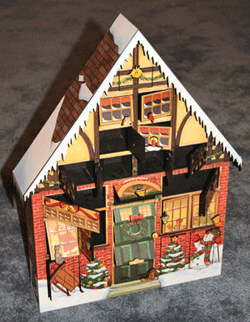|

|
Art & Antiques by Dr. Lori
Collecting Advent Calendar
|
By Lori Verderame
Posted December 2015
Photo: A free-standing Advent calendar house.
From the Latin term adventus, Advent means “the arrival.” For centuries, Advent has been a time of spiritual reflection for Christians in anticipation of the birth of Jesus Christ.
 It is believed that the period of Advent has been observed since about the 4th century A.D. In the early days of observing Advent, the time frame lasted from the feast day of Saint Martin held on November 11 until Christmas Day which takes place on December 25. Similar to the springtime season of Lent, Advent once included a six-week long fast for believers, however, that has since been discontinued. By the 6th century, Advent no longer had a fasting ritual like Lent and the Advent season was reduced from six weeks to only four weeks in length. Today, the season of Advent remains a time of devotional prayer and anticipation of the Christmas holiday. It is believed that the period of Advent has been observed since about the 4th century A.D. In the early days of observing Advent, the time frame lasted from the feast day of Saint Martin held on November 11 until Christmas Day which takes place on December 25. Similar to the springtime season of Lent, Advent once included a six-week long fast for believers, however, that has since been discontinued. By the 6th century, Advent no longer had a fasting ritual like Lent and the Advent season was reduced from six weeks to only four weeks in length. Today, the season of Advent remains a time of devotional prayer and anticipation of the Christmas holiday.
Like many holiday collectibles, objects relating to Advent such as Advent wreaths and Advent candles mark the days leading up to Christmas. Advent wreaths, a circle of evergreens symbolizing eternal life, are widely used. The four red candles represent the four Sundays of the Advent period and a fifth white candle in the wreath’s center is called the Christ candle. The Christ candle is the last one to be lit, and it is lit only on Christmas Day.
Quite possibly the most recognized of the season’s traditions is the use of the popular Advent calendar. For many collectors, the chronological countdown to Christmas Day comes in the form of an antique or vintage paper, lithographed, felt, painting on canvas, or mixed media Advent calendar. The Advent calendar is particularly popular with children, many of whom spend the greater part of the month of December patiently awaiting the arrival of Santa Claus and counting down the days by opening doors of an Advent calendar in order.
According to legend, the first known Advent Calendar was handmade in 1851. By the 1880s, the Germanic tradition of the Advent calendar began to spread across Europe to North America. Typically made of printed images on paper or cardboard, Advent calendars boast 24 small numbered doors to be opened daily in anticipation of Christmas. Snow-covered houses, holiday scenes, and winter wonderlands were common imagery used as the backdrop for the 24 miniature doors on Advent calendars. Each Advent calendar door is opened to reveal a holiday image such as a Bible passage, a piece of candy, or a small gift, starting on December 1 and continuing until Christmas Eve on December 24.
The “father” of the modern Advent calendar was a German printer named Gerhard Lang. While working from his Munich, Germany printing office, Lang produced small colorful, religious images on paper and cardboard. Each image corresponded to one day in the month of December up to December 24. Circa 1908, Lang produced the first Advent calendar that had cardboard doors that opened to reveal the image inside. Throughout much of the early 20th century, Advent calendars were exchanged as gifts around the Thanksgiving holiday in anticipation of Christmas.
When it comes to value of Advent calendars, the characteristics you should look for are good condition (no rips, tears or stains), intricate patterns or images of a winter scene or holiday events in bright colors, and famous printmakers like Lang, Sankt Johannis, etc.
Today, Advent calendars have evolved from lithograph printed images on cardboard to free-standing dollhouse-style collectible calendars with hinged doors to hide small gifts, money or candy. Some of these contemporary holiday collectibles are made of pressed board, Masonite, and even wood. For collectors, expect to pay $50 to $500 for some of the traditional paper Advent calendars and several thousands of dollars for handmade or handcrafted Advent calendars. Happy holidays!
Dr. Lori Verderame is an antiques appraiser, nationally syndicated columnist and author, and award-winning TV personality who stars on Discovery’s Auction Kings internationally. With a Ph.D. from Penn State University and experience appraising 20,000 antiques every year, Dr. Lori presents antique appraisal events to worldwide audiences. Visit www.DrLoriV.com/Events, www.Facebook.com/DoctorLori, Lori Verderame on Google+ or call (888) 431-1010.
|